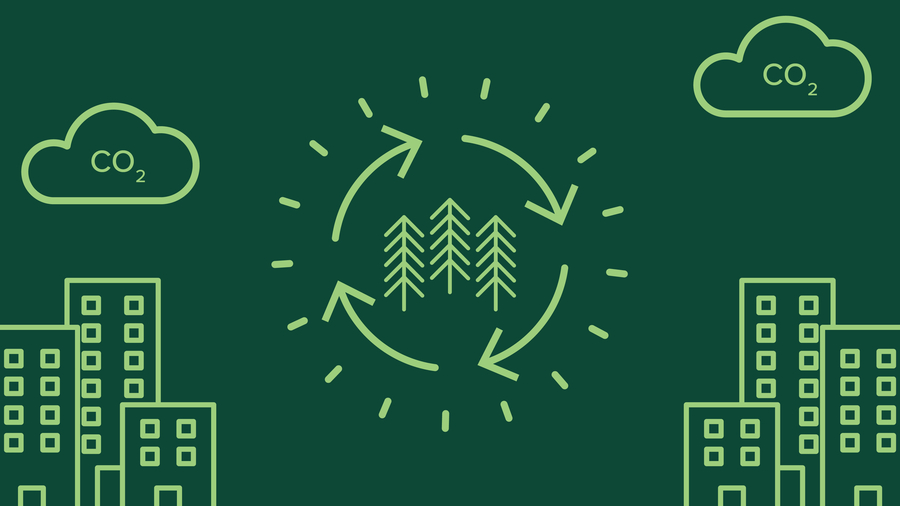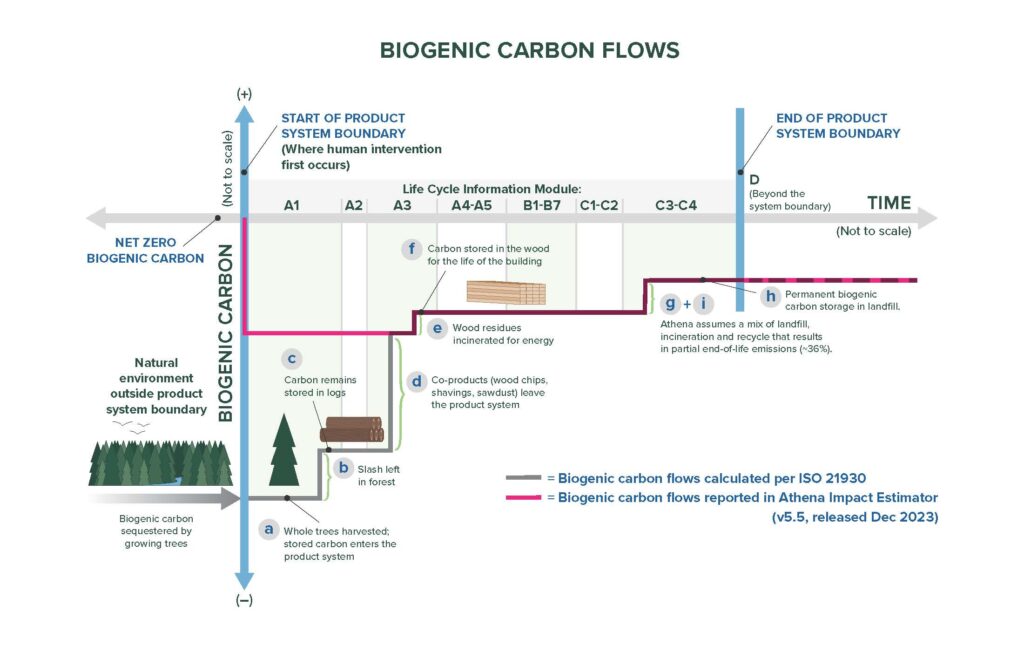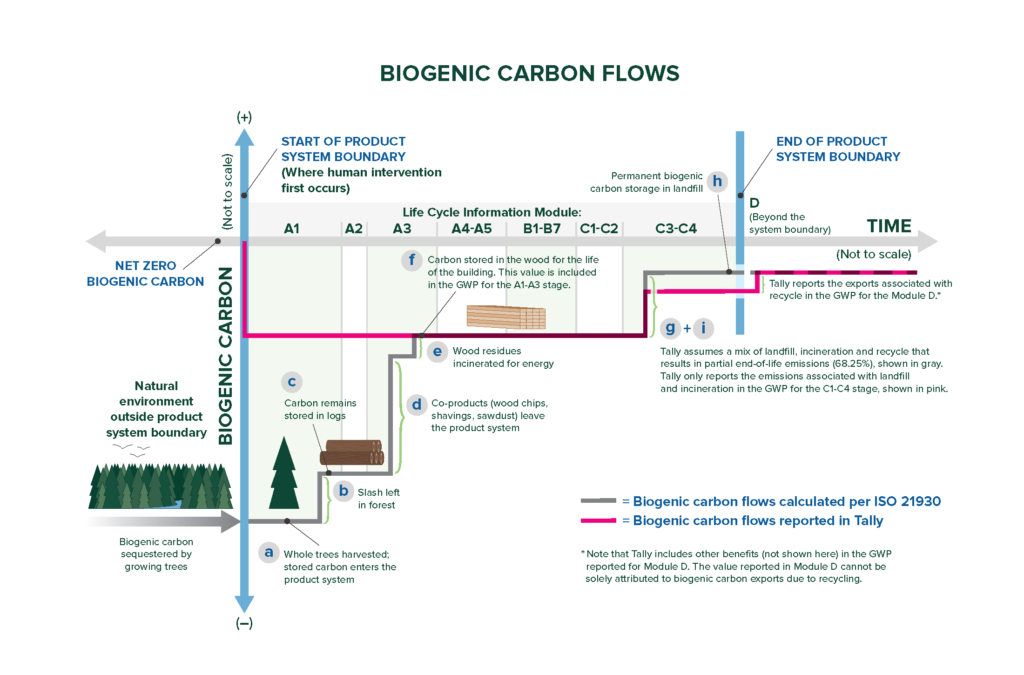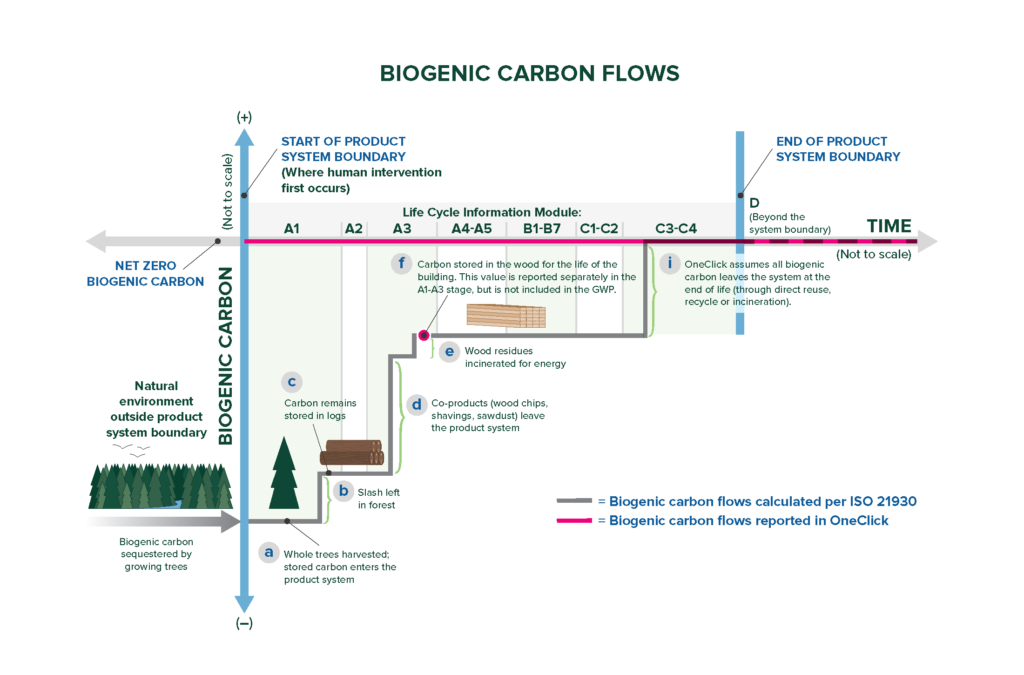Expert Tips
Biogenic Carbon Accounting in WBLCA Tools
Part 3 in a series on biogenic carbon accounting for wood products – the nuances of different tools

Updated January 2024
Before reading this article, please review Part 1, When to Include Biogenic Carbon in an LCA, and Part 2, How to Include Biogenic Carbon in an LCA. In this article, we’ll explore how biogenic carbon accounting is performed in three whole building life cycle assessment (WBLCA) tools.
Within WBLCA tools, designers sometimes have the option to “include” or “exclude” biogenic carbon flows. Generally speaking, “including biogenic carbon” means you are following the “-1 in/+1 out” biogenic carbon accounting practice in accordance with ISO 21930. As outlined in Part 1, biogenic carbon flows should be included when wood is sourced from the U.S., Canada, or any other country with stable or increasing forest carbon stocks,1 or when responsibly sourced or certified lumber is used.2 When it is included, all of the biogenic carbon flows mentioned in Part 2 should be reported in the appropriate module. In practice, however, each of the tools handles biogenic carbon in different ways.
Athena Impact Estimator
Note: In December 2023, the Athena Sustainable Materials Institute released significant revisions to its LCA tool, the Athena Impact Estimator for Buildings. The following information is based on this release, which is v5.5.
By default, the Athena Impact Estimator includes biogenic carbon flows that occur in each life cycle stage. Biogenic carbon enters the system in A1 and some biogenic carbon leaves the system in A3. In Module A5, Athena applies a waste factor based on material and product type, resulting in additional biogenic carbon entering and leaving the system. In Modules C3-C4, Athena uses a mix of end-of-life scenarios:
- 72.6% of the wood products are landfilled.3
- 88% of the biogenic carbon that enters the landfill is permanently stored.
- The remaining 12% decomposes and is released back to the atmosphere.
- 27.4% of the wood products are assumed to leave the product system for recycling or other use. All biogenic carbon stored in this material leaves the system as an emission or export.
This mix of end-of-life scenarios results in about 64% permanent biogenic carbon storage while the remaining 36% is released. These assumptions are set by the program and cannot be adjusted by the user.

Figure 1: Biogenic Carbon Reporting in Athena Impact Estimator 4
Click here to view a larger version of this image.
Tally
Tally gives users the option to include or exclude biogenic carbon flows. As noted above, users should choose to “include” biogenic carbon to align with ISO standards. When this selection is made, biogenic carbon enters the system in A1 and some biogenic carbon leaves the system in A3. The net value, depicted at point “f” of Figure 2, is included in the GWP reported for the product stage (A1-A3). As noted in Part 2 of this series, Tally assumes a default lifespan of 30 years for certain wood products5 during the “use” stage (Module B). This default setting must be manually changed by the user, to reflect the fact that structural wood products are designed with a lifespan equal to that of the building.
For the end-of-life stage, Tally also uses a mix of three scenarios, although the percentages are different than those used in Athena.
- 63.5% of the wood products are landfilled.
- 50% of the biogenic carbon that enters the landfill is permanently stored.
- The remaining 50% decomposes and is released back to the atmosphere.
- 22% of the wood products are incinerated. All biogenic carbon stored in this material is released back to the atmosphere as an emission.
- 14.5% of the wood products are recycled. All biogenic carbon stored in this material leaves the system to be passed on to the next life cycle.
This mix of end-of-life scenarios ultimately results in 31.75% permanent biogenic carbon storage, depicted at point “h” of Figure 2. The remaining 68.25% is released from the system, depicted by the gray line at “g+i.” These assumptions are set by the program and cannot be adjusted by the user. Note, however, that Tally reports only the emissions associated with landfill and incineration in Module C1-C4. Biogenic carbon that leaves the product system due to recycling is reported in Module D, as depicted by the pink line. Module D also includes other benefits and impacts such as energy recovery and use of that energy to offset energy from the grid, not shown. It is difficult to disaggregate this data to determine only the portion of biogenic carbon that leaves the system through recycling to be passed on to the next system.

Figure 2: Biogenic Carbon Reporting in Tally (when biogenic carbon is included)4
Click here to view a larger version of this image.
When biogenic carbon is excluded in Tally, no credit is given in Module A1 for the biogenic carbon stored in the log when it enters the system. Similarly, when wood products leave the system or are incinerated, biogenic carbon emissions are not reported; however, biogenic methane emissions from landfill decomposition are still reported. Because biogenic carbon flows are not reported, there is no permanent biogenic carbon storage.
OneClick LCA
OneClick calculates the amount of biogenic carbon stored in the wood products but does not report biogenic carbon flows over the life cycle, nor does it include biogenic carbon in the overall GWP. Biogenic carbon enters the system in A1 and some biogenic carbon leaves the system in A3. In Module C3, the default assumption is that 100% of biogenic carbon within the system is emitted. In other words, OneClick does not include any permanent biogenic carbon storage, regardless of whether the default or a custom end-of-life scenario is used. Because OneClick does not include biogenic carbon in the reported GWP, biogenic carbon flows (-1 in/+1 out) are not reported within each module. Rather, the amount of biogenic carbon stored in the wood products is reported separately in Modules A1-A3 and is assumed to be stored for the life of the building. This is depicted at point “f” of Figure 3.

Figure 3: Biogenic Carbon Reporting in OneClick LCA4
Click here to view a larger version of this image.
While there are differences in reporting methodologies and assumptions between different WBLCA tools, designers should look for tools—and options within those tools—that include biogenic carbon flows in accordance with ISO 21930. Consideration should be given to end-of-life scenarios, as these can have significant effects on the reported amount of permanently stored biogenic carbon. Additionally, tool users should be familiar with default material lifespans within each tool and adjust as necessary to ensure accurate results.
Additional Resources:
Athena Sustainable Materials Institute. (2023, December). User Manual and Transparency Document: Impact Estimator for Buildings v.5.5.
International Organization for Standardization. (2017). ISO 21930:2017 Sustainability in buildings and civil engineering works – Core rules for environmental product declarations of construction products and services.
Kwok, A. G., Zalusky, H., Rasmussen, L., Rivera, I., & McKay, H. Tallwood Design Institute. (2019). Cross-Laminated Timber Buildings: A WBLCA Case Study Series.
One Click LCA. (2022, February). One Click LCA Help Centre: Biogenic Carbon.
Skog, K. E. (2008). Sequestration of carbon in harvested wood products for the United States. Forest Products Journal. Vol. 58, no. 6; 56-72.
Wildnauer, M. KT Innovations. (2018, October). Tally 2019 Webinar Series: Biogenic Carbon.
1 ISO 21930 Section 7.2.11 Note 2
2 ISO 21930 Section 7.2.11
3 EPA. Advancing Sustainable Materials Management: 2018 Fact sheet. (2020, December). Table 8.
4 For further explanation of this graph, see Part 2 of this series on biogenic carbon accounting over the life cycle of a wood product.
5 Tally Tutorial, “Defining Materials” starting at 0:02:33, https://choosetally.com/tutorials/



